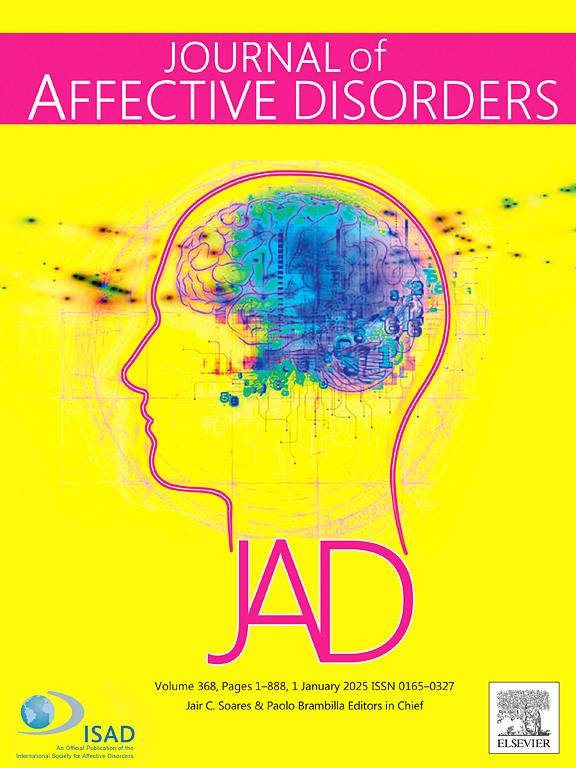Suicidal obsessions from suicidal ideation: A first-person suicide image pilot study
IF 4.9
2区 医学
Q1 CLINICAL NEUROLOGY
引用次数: 0
Abstract
Individuals with obsessive-compulsive disorder (OCD) experience unwanted and intrusive thoughts that cause anxiety and/or distress. The content of these thoughts can vary widely. Suicidal obsessions (SOs) are unwanted, intrusive, and distressing thoughts about suicide, death, or self-harm. Their clinical presentation differs markedly from that of suicidal ideation (SI), yet most suicide risk assessments fail to distinguish between the two phenomena. The distinction is critical, as SOs and SI differ in their clinical risk and require different treatments. This pilot study compares the self-reported affective ratings of first-person suicide images (FPSIs) by individuals with OCD presenting suicidal obsessions to ratings by individuals with OCD with suicidal ideation. Compared with those with SI, those with SOs found the images less pleasant, more threatening, more arousing, less aligned with behaviors they could imagine themselves engaging in, and less aligned with their sense of self. The difference in imagined behavioral engagement was statistically significant. After controlling for depressive and OCD symptom severity, regression models indicated a large negative effect for arousal (β = −1.05), medium effects for ego syntonicity (β = 0.64), behavioral relatedness (β = 0.58), and a sense of threat (β = −0.68, p = 0.55), and a small positive effect for pleasantness ratings (β = 0.33). These effects did not individually reach statistical significance in this pilot study but serve to guide future work. Differentiating between SI and SOs is clinically imperative as it frames treatment planning. The use of FPSIs may supplement traditional suicide measures and functional assessment in making this key distinction.
来自自杀意念的自杀强迫症:第一人称自杀图像试点研究
患有强迫症(OCD)的人会经历不必要的、侵入性的想法,这些想法会导致焦虑和/或痛苦。这些想法的内容可以有很大的不同。自杀强迫症(so)是关于自杀、死亡或自残的不必要的、侵入性的、痛苦的想法。他们的临床表现明显不同于自杀意念(SI),然而大多数自杀风险评估未能区分这两种现象。这种区别是至关重要的,因为SOs和SI的临床风险不同,需要不同的治疗方法。本初步研究比较了有自杀倾向的强迫症患者和有自杀意念的强迫症患者对第一人称自杀图像(FPSIs)的自我报告情感评分。与那些有SI的人相比,那些有so的人发现这些图像不那么令人愉快,更有威胁性,更令人兴奋,更不符合他们想象自己参与的行为,更不符合他们的自我意识。想象行为投入的差异在统计上是显著的。在控制抑郁和强迫症症状严重程度后,回归模型显示,唤醒(β = - 1.05)有较大的负作用,自我同一性(β = 0.64)、行为相关性(β = 0.58)和威胁感(β = - 0.68, p = 0.55)有中等作用,愉悦度评分有较小的正作用(β = 0.33)。这些影响在本初步研究中没有单独达到统计显著性,但可以指导未来的工作。区分SI和SOs在临床上是必要的,因为它构成了治疗计划。fpsi的使用可以补充传统的自杀措施和功能评估,以做出这一关键区分。
本文章由计算机程序翻译,如有差异,请以英文原文为准。
求助全文
约1分钟内获得全文
求助全文
来源期刊

Journal of affective disorders
医学-精神病学
CiteScore
10.90
自引率
6.10%
发文量
1319
审稿时长
9.3 weeks
期刊介绍:
The Journal of Affective Disorders publishes papers concerned with affective disorders in the widest sense: depression, mania, mood spectrum, emotions and personality, anxiety and stress. It is interdisciplinary and aims to bring together different approaches for a diverse readership. Top quality papers will be accepted dealing with any aspect of affective disorders, including neuroimaging, cognitive neurosciences, genetics, molecular biology, experimental and clinical neurosciences, pharmacology, neuroimmunoendocrinology, intervention and treatment trials.
 求助内容:
求助内容: 应助结果提醒方式:
应助结果提醒方式:


